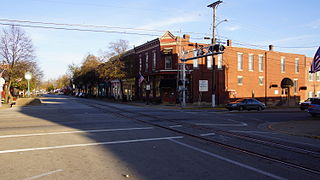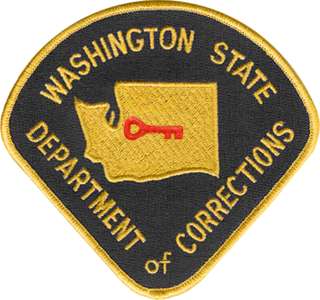Related Research Articles

La Grange is a home rule-class city in Oldham County, Kentucky, in the United States. The population was 10,067 at the time of the 2020 U.S. census. It is the seat of its county. An unusual feature of La Grange is the CSX Transportation street-running mainline track on Main Street.

The Washington State Department of Corrections (WADOC) is a department of the government of the state of Washington. WADOC is responsible for administering adult corrections programs operated by the State of Washington. This includes state correctional institutions and programs for people supervised in the community. Its headquarters are in Tumwater, Washington.
Prison Fellowship is the world's largest Christian nonprofit organization for prisoners, former prisoners, and their families, and a leading advocate for justice reform.

Incarceration in the United States is a primary form of punishment and rehabilitation for the commission of felony and other offenses. As of January 2023, the United States has the sixth highest per-capita incarceration rate in the world, at 505 people per 100,000; and the second largest prison population in the world. In 2018, the United States had the highest incarceration rate in the world, with 698 people incarcerated per 100,000; this includes the incarceration rate for adults or people tried as adults. This meant that one out of every 5 people imprisoned across the world in 2018 was incarcerated in the United States. Prison, parole, and probation operations generate an $81 billion annual cost to U.S. taxpayers, with an additional $63 billion for policing. Court costs, bail bond fees, and prison phone fees generate another $38 billion in individual costs.

Recidivism is the act of a person repeating an undesirable behavior after they have experienced negative consequences of that behavior. It is also used to refer to the percentage of former prisoners who are rearrested for a similar offense.

The Federal Bureau of Prisons (BOP) is a United States federal law enforcement agency under the Department of Justice that is responsible for the care, custody, and control of incarcerated individuals who have committed federal crimes; that is, violations of the United States Code.

Prison education is any educational activity that occurs inside prison. Courses can include basic literacy programs, secondary school equivalency programs, vocational education, and tertiary education. Other activities such as rehabilitation programs, physical education, and arts and crafts programs may also be considered a form of prison education. Programs are typically provided, managed, and funded by the prison system, though inmates may be required to pay for distance education programs. The history of and current practices in prison education vary greatly among countries.

A super-maximum security (supermax) or administrative maximum (ADX) prison is a "control-unit" prison, or a unit within prisons, which represents the most secure level of custody in the prison systems of certain countries.

The Penal system of Japan is part of the criminal justice system of Japan. It is intended to resocialize, reform, rehabilitate and punish offenders. The penal system is operated by the Correction Bureau of the Ministry of Justice.
A prison nursery is a section of a prison that houses incarcerated mothers and their very young children. Prison nurseries are not common in correctional facilities in the United States, although prior to the 1950s many states had them and they are widespread throughout the rest of the world.

The Indiana Women's Prison was established in 1873 as the first adult female correctional facility in the country. The original location of the prison was one mile (1.6 km) east of downtown Indianapolis. It has since moved to 2596 Girls School Road, former location of the Indianapolis Juvenile Correctional Facility. As of 2005, it had an average daily population of 420 inmates, most of whom are members of special-needs populations, such as geriatric, mentally ill, pregnant, and juveniles sentenced as adults. By the end of 2015, the population increased to 599 inmates. Security levels range from medium to maximum. The prison holds Indiana's only death row for women; however, it currently has no death row inmates. The one woman under an Indiana death sentence, Debra Denise Brown, had her sentence commuted to 140 years imprisonment in 2018 and is being held in Ohio.

The Kentucky State Penitentiary (KSP), also known as the "Castle on the Cumberland," is a maximum security and supermax prison with capacity for 856 prisoners located in Eddyville, Kentucky on Lake Barkley on the Cumberland River, about 4.8 kilometres (3 mi) from downtown Eddyville. It is managed by the Kentucky Department of Corrections. Completed in 1886, it is Kentucky's oldest prison facility and the only commonwealth-owned facility with supermax units. The penitentiary houses Kentucky's male death row inmates and the commonwealth's execution facility. As of 2015 it had approximately 350 staff members and an annual operating budget of $20 million. In most cases, inmates are not sent directly to the penitentiary after sentencing, but are sent there because of violent or disruptive behavior committed in other less secure correctional facilities in the commonwealth. This was Kentucky's second penitentiary. The first Kentucky State Penitentiary in Frankfort was made uninhabitable from the 1937 flood.
The Luther Luckett Correctional Complex is a Medium/MINIMUM-security state prison located in Oldham County, near La Grange, Kentucky, about 30 miles northeast of Louisville. It opened in 1981 and had a prison population 1,204 as of 2018. The Kentucky Correctional Psychiatric Center, which is operated by the Kentucky Health and Family Services Cabinet and is officially a separate facility, is located within the Luther Luckett Correctional Complex and shares several facilities with its host prison.

Kentucky State Reformatory (KSR) is a medium-security prison for adult males. The prison is located in unincorporated Oldham County, Kentucky, near La Grange, and about 30 miles (48 km) northeast of Louisville. It opened in 1940 to replace the Kentucky State Penitentiary in Frankfort after a flood damaged the original property. The current (2020) capacity of KSR is 1053 inmates.

A prison, also known as a jail, gaol, penitentiary, detention center, correction center, correctional facility, lock-up, hoosegow or remand center, is a facility in which inmates are confined against their will and usually denied a variety of freedoms under the authority of the state as punishment for various crimes. Prisons are most commonly used within a criminal justice system: people charged with crimes may be imprisoned until their trial; those pleading or being found guilty of crimes at trial may be sentenced to a specified period of imprisonment. In simplest terms, a prison can also be described as a building in which people are legally held as a punishment for a crime they have committed.
Rehabilitation Through The Arts (RTA) was founded by Katherine Vockins in 1996 in Sing Sing Correctional Facility in Ossining, New York, and now operates in six men's and women's, maximum and medium security New York State prisons: Sing Sing, Bedford Hills, Woodbourne, Green Haven, Fishkill and Taconic. RTA is the lead program of Prison Communities International, a 501c3 tax-exempt non-profit organization. RTA brings art workshops in theatre, music, dance, visual arts, writing and poetry behind the walls to over 230 incarcerated men and women.
Infectious diseases within American correctional settings are a concern within the public health sector. The corrections population is susceptible to infectious diseases through exposure to blood and other bodily fluids, drug injection, poor health care, prison overcrowding, demographics, security issues, lack of community support for rehabilitation programs, and high-risk behaviors. The spread of infectious diseases, such as HIV and other sexually transmitted diseases, hepatitis C (HCV), hepatitis B (HBV), and tuberculosis, result largely from needle-sharing, drug use, and consensual and non-consensual sex among prisoners. HIV and hepatitis C need specific attention because of the specific public health concerns and issues they raise.
Earnest C. Brooks Correctional Facility (LRF) is a Michigan prison, located in Muskegon, for adult male prisoners.
Prisoner reentry is the process by which prisoners who have been released return to the community. Many types of programs have been implemented with the goal of reducing recidivism and have been found to be effective for this purpose. Consideration for the conditions of the communities formerly incarcerated individuals are re-entering, which are often disadvantaged, is a fundamental part of successful re-entry.
References
- ↑ "Shakespeare Behind Bars – Mission & Vision". Shakespeare Behind Bars. Retrieved 26 April 2016.
- ↑ Rosen, Marty (20 May 2015). "THEATER: Shakespeare Behind Bars". LEO Weekly.
- ↑ "Shakespeare Behind Bars – Staff". Shakespeare Behind Bars. Retrieved 26 April 2016.
- ↑ "Shakespeare Behind Bars – Timeline of Program History". Shakespeare Behind Bars. Retrieved 26 April 2016.
- ↑ Chideya, Farai (21 August 2006). "Dramatic Redemption: 'Shakespeare Behind Bars'". NPR.org.
- ↑ Belden, Bret (4 April 2016). "The New Hampshire : UNH brings founder of 'Shakespeare Behind Bars' to MUB". The New Hampshire.
- ↑ "Shakespeare Behind Bars – Staff". Shakespeare Behind Bars. Retrieved 26 April 2016.
- 1 2 White, Sue (13 February 2012). "'Shakespeare Behind Bars' brings story of artistic redemption to Saginaw Valley State University". MLive.com.